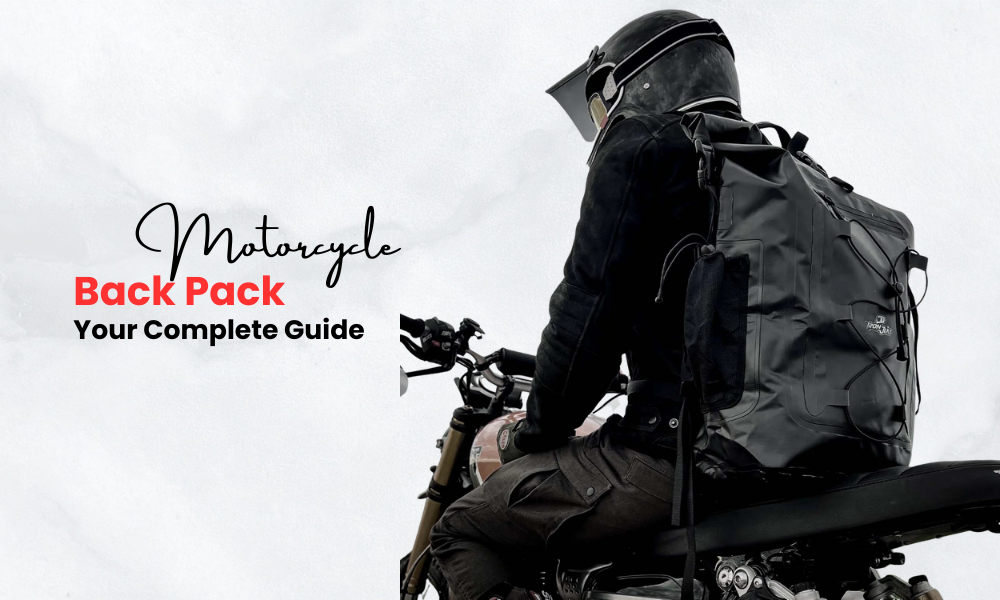Motorcycle Backpack: Your Complete Guide to Choosing the Perfect Riding Bag

Finding the right backpack for your motorcycle rides can change everything. Whether you’re heading to work or planning a weekend trip, you need something that keeps your stuff safe without getting in the way.
Regular backpacks don’t work well on motorcycles. They move around too much, catch the wind like a sail, and can mess up your balance when you’re riding. That’s exactly why motorcycle backpacks exist. They are made differently, with features that actually make sense for riders.
What Makes Motorcycle Backpacks Special?
A motorcycle backpack is not like the one you carried to school. These bags are built to handle real riding challenges.
First off, they stay in place. You get chest straps and waist straps that lock everything down tight. When you are leaning into a turn or going over bumps, the last thing you want is your bag flopping around. A shifting backpack at the wrong moment? That’s asking for trouble.
The materials are way tougher, too. Your bag sits out in the wind every single ride. Rain hits it. The sun beats down on it. Vibrations shake it constantly. Cheap materials fall apart fast. Motorcycle backpacks use heavy-duty stuff like reinforced nylon that actually lasts.
Safety features matter here. Lots of these bags have reflective strips sewn in. Cars can spot you better at night, which might just save your skin. Some even have pockets where you can slide in back protectors for extra safety. And just like you would not ride without good motorcycle gloves, you shouldn’t settle for a cheap bag either.
Types of Motorcycle Backpacks You Should Know
Commuter Backpacks work great for everyday work rides. They’re not huge, they look professional enough for the office, and they usually have laptop sleeves. Most hold around 15 to 25 liters, which is plenty for daily stuff.
Adventure Backpacks are the tough guys. Built for long trips and nasty weather. They’re completely waterproof, hold way more gear (30 to 40 liters), and can take serious abuse. Planning to ride trails or tour across states? This is what you want.
Urban Riding Backpacks focus on looking good and staying organized. They’re lighter, have tons of pockets for keeping things neat, and don’t scream “motorcycle gear” when you walk into a coffee shop. Perfect for city riders.
Must-Have Features in a Good Motorcycle Backpack
Straps That Actually Work
The strap setup can make or break your whole experience. You absolutely need adjustable shoulder straps, plus a chest strap, and really should have a waist belt too. All three work together to spread the weight around and keep that bag glued to your back.
Get the adjustments right, and you will forget you are even wearing it. Everything feels natural. Get them wrong, and you’ll be fighting the bag the whole ride.
Weather Protection
Rain shows up whether you like it or not. Your backpack better be ready for it. Water-resistant bags handle drizzle okay. Fully waterproof bags laugh at heavy storms.
Look for roll-top closures, sealed seams, and waterproof zippers. These keep your laptop, phone, and wallet dry when clouds open up. Just like you need weather protection for your gear, grabbing some quality winter motorcycle gloves keeps your hands working in cold weather.
Capacity Matters
The size of the backpack is measured in liters. Between 20 and 25 liters are just right in the case of daily commuting. You will be able to carry your laptop, lunch box, phone charger, wallet, and perhaps a light jacket, but not jam-packed.
Going on longer rides? Adventure touring requires 30 to 40 liters. The additional space is filled with camping supplies, spares of a couple of days, small tools, and emergency kits. You will enjoy the room miles away when you are far from home.
Small bags of about 15 to 20 liters are appropriate when one has to make a quick run or has a brief ride. They are small, cannot find any wind, and will not make one feel heavy. Perfect when it comes to going to the grocery or meeting your friends at the other end of town.
Padding and Comfort
Your back and shoulders will hurt on long rides if you skip good padding. Thick shoulder straps matter. A padded back panel matters. Breathable mesh that lets air through matters a lot.
Some bags have special designs that create airflow behind your back. Your shirt won’t get soaked with sweat in summer. Comfort applies everywhere, which explains why riders spend good money on proper motorcycle boots, too.
Matching Your Backpack to Your Riding Style
Daily commuters need laptop protection and pockets they can easily reach. Get a bag with padded sleeves for 15-inch computers, tablet spots, and front pockets you can grab without removing the pack. A 20 to 22 liter size handles work stuff, lunch, and daily items without looking huge.
Weekend sport riders hitting canyon roads want slim bags that won’t catch wind at speed. Skip those big 40-liter adventure packs. Grab something 18 to 25 liters with compression straps that pull tight. You need space for a jacket, snacks, and basic tools without the bag turning into a sail.
Long-range touring riders traveling 300 miles or more in a day require actual space and comfort. Obtain 30 to 40 liter bags which are thickly padded, have ventilated back panels, and waist belts that effectively carry weight. You will be wearing this for hours on end, hence comfort is better than being stylish. Ensure that it has a hydration bladder as well.
Off-road and adventure riders are the most challenged. Your bag needs complete waterproofing, not just water resistance. Roll-top closures beat zippers in mud and dust. Get bags with external attachment spots for strapping extra gear. The 25 to 35 liter range gives flexibility without getting too bulky on technical trails.
Common Mistakes to Avoid
Don’t stuff your backpack until it’s bursting. Too much weight throws off your balance and kills your shoulders. Need to haul a ton of stuff regularly? Maybe add saddlebags to your bike instead.
Never ride with loose straps. A backpack that’s not adjusted right is actually dangerous. Spend five minutes getting the fit correct before you take off. It matters.
Skip backpacks without reflective stuff if you ride at night. Getting seen by cars could literally save your life. Visibility counts for everything, which is why wearing proper motorcycle jackets with reflective strips helps drivers notice you.
Caring for Your Motorcycle Backpack
Wipe your bag down every couple of weeks. Road dirt and grime eat away at materials slowly. A quick cleaning keeps things lasting longer.
Check zippers and straps monthly. It is best to get a minor issue at this stage rather than a strap breaking when you are riding along the highway at 60 miles per hour.
When you are not using your backpack, keep it in a place that is dry. Materials are more durable, and you will not have the ugly musty smell.
Waterproof coatings wear off over time. You might need to reapply treatment every year or two to keep water out properly.
Price Guide: What to Expect
Budget backpacks ($50-$100) give you the basics and decent enough quality. They work fine if you ride occasionally or have just started riding.
Mid-range options ($100-$200) use better materials, add more features, and last longer. Most regular riders find their sweet spot here. Good value without emptying your wallet.
Premium backpacks ($200-$300+) come from big motorcycle brands and use the absolute best materials. They’re built to survive years of heavy daily use. Worth it if you ride constantly.
Spending money on quality gear makes sense long-term. The same logic applies to other essential stuff, like motorcycle pants that protect your legs every time you ride.
Why Size Really Matters
Getting size right makes such a huge difference. Here’s what works:
Small bags (15-20L) are used to deal with short trips and light commute.Smaller size, reduced wind resistance, easier to handle generally.
Medium bags (20-30L) are what most commuters pick. Space to break, eat, wash my clothes, perhaps a book. Not too big, not too small.
Large bags (30-40L+) are used to go on tour, or camp, or carry a lot of equipment. They weigh a lot and are large, and you must be sure that you really need all the space.
Essential Gear Beyond Your Backpack
Your backpack keeps your belongings; however, other equipment keeps you alive. You need a complete setup.
Good motorcycle helmets serve to help your brain in case things go wrong. Always invest in your helmet, not even during a tight time. Your head is worth rather than fifty bucks.
Your hands are battered by wind, cold, and possible crashes. Motorcycle gloves are good and make your grip better, and cover you up, but not like oven mitts.
Protection of legs is neglected too frequently. Armed motorcycle pants are made of solid material, which makes them safer in case of falls and comfortable enough to ride all day.
Don’t forget your feet either. The motorcycle boots provide you with ankle protection, crash protection that cannot be experienced with sneakers.
Making Your Final Choice
You probably know what you neBetter to catch a small problem now than have a strap snap while you’re riding down the highway at 60 miles per hour.ed by now. Quick checklist before buying:
- Got chest and waist straps?
- Weather protection good enough for your area?
- Does your daily stuff actually fit?
- Does it have the pockets and organization you want?
- Does it feel comfortable when you try it on?
- Price fits what you can spend?
Answer yes to most of these questions, and you have found your match.
Conclusion
The right motorcycle backpack transforms your rides. Your gear stays safe, you stay comfortable all day, and riding feels natural instead of awkward.
Don’t use a regular backpack that wasn’t designed for motorcycles. The safety and comfort difference is massive. Figure out your riding style first, decide what size makes sense, then focus on features that actually matter to you.
Remember something important: a backpack’s just one piece of your riding gear. Building a complete safety setup protects you way better and makes every single ride more enjoyable.
Ready to upgrade your complete riding experience? Explore premium motorcycle gear at Six Gear, including helmets, gloves, jackets, boots, and pants. Get the protection and comfort you deserve on every ride. Shop now and ride safer tomorrow!

















